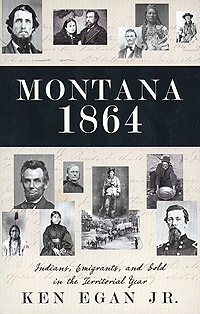
Ken Egan, director of Humanities Montana, has authored a very engaging synopsis of the year that Montana became a territory. Book chapters, which correspond to the months of the year, trace various events that occurred each month in 1864.
The format not only provides insights into what was happening, but also offers a Native American perspective of what each month meant to various tribes: March is the Geese Arrive Moon. It is also known as the time that Napi Comes Running Down Off of the Mountains, the Moon of the Warm Chinook Winds. It is the moon of the gophers, too. Poems and passages by Native Americans are spliced with journal entries, newspaper accounts and Egan’s own rich imagining of time, place and people.
The book brims with entertaining vignettes about many Montana historical characters, including Henry Plummer, Father De Smet, James Fergus, Calamity Jane, Plenty Coups, Jim Bridger, John Bozeman, Wilbur Sanders and, of course, our first territorial governor, Sidney Edgerton, all neatly packaged in a timeline. December, for example, was the month “in which Judge Hosmer calls out the Vigilantes, Governor Edgerton calls the first legislature into session, and Calamity Jane arrives in Montana.”
Many of those same characters became the namesakes of our communities, counties and landmarks. The book also reveals how Montana’s fate was entwined with the Civil War. Many gold seekers, such as the notable Four Georgians who discovered gold on Last Chance Gulch, were actually southerners who fled the South during the war. Most were Confederate sympathizers. There was clearly concern within the Lincoln Administration that this new territory, if allowed to become a state, could be sympathetic to the Confederate cause.
Fortunately, the Civil War was winding down, but the sympathies of the populace probably slowed the statehood process. It was obvious from the first election that there was an even divide among legislators loyal to the Union and those still devoted to the Confederate cause. Montana still had to wait another 25 years to become a state, thus enduring a longer maturation process.
Egan’s book offers a quick, delightful read for anyone interested in the birth of our state – and an important reminder of the role Montana played in economic development and the politics of an emerging nation. Published by Riverbend in Helena, it sells for $19.95 softcover.
– Graydon Moll